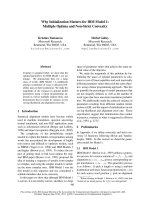Negotiations chap010 multiple parties and teams
Bạn đang xem bản rút gọn của tài liệu. Xem và tải ngay bản đầy đủ của tài liệu tại đây (189.13 KB, 14 trang )
CHAPTER TEN
Multiple Parties
and Teams
McGraw-Hill/Irwin
Copyright © 2011 by The McGraw-Hill Companies, Inc. All rights reserved.
10-2
Situations that Involve
Multiple Parties
• Dynamics change when groups, teams, and
task forces have to present individual views
and come to a collective agreement about a
problem, plan, or future course of action.
A General Model for
a Multiparty Negotiation
10-3
10-4
The Nature of Multiparty
Negotiations
Differences between two-party and
multiparty negotiations:
•
•
•
•
•
Number of parties
Informational and computational complexity
Social complexity
Procedural complexity
Strategic complexity
10-5
What Is an Effective Group
in a Multiparty Negotiation?
Effective groups and their members:
1.
2.
3.
4.
5.
6.
7.
8.
Test assumptions and inferences
Share all relevant information
Focus on interests, not positions
Explain reasons behind statements
Talk in specific terms and use examples
Agree on what important words mean
Disagree openly with any member of the group
Make statements, then invite questions and comments
10-6
What Is an Effective Group
in a Multiparty Negotiation?
Effective groups and their members (continued)
9.
10.
11.
12.
13.
Design ways to test disagreements and solutions
Discuss “undiscussable” issues
Keep discussions focused
Avoid taking cheap shots or distracting the group
Expect participation by all members in all phases of the
process
14. Exchange relevant information with nongroup members
15. Make decisions by consensus
16. Conduct self-critiques
10-7
Managing Multiparty
Negotiations
Three key stages that characterize multilateral
negotiations.
• The prenegotiation stage
– Characterized by many informal contacts among the parties
• The formal negotiation stage
– Structures a group discussion to achieve an effective and
endorsed result
• The agreement phase
– Parties select among the alternatives on the table
10-8
The Prenegotiation Stage
•
•
•
•
Establish participants
Form coalitions
Define group member roles
Understand the costs and consequences of no
agreement
• Learn the issues and construct an agenda
10-9
The Prenegotiation Stage
Agendas can be effective decision aids:
• Establish the issues that will be discussed
• Define how each issue is discussed
• Set the order in which issues are discussed
• Introduce process issues (decision rules,
discussion norms, member roles, discussion
dynamics), and substantive issues
• Assign time limits to various items
10-10
The Formal Negotiation Stage
• Appoint an appropriate chair
• Use and restructure the agenda
• Ensure diversity of information and perspectives
– Key process steps:
• Collect thoughts and composure before speaking
• Understand the other person’s position
• Think of ways both parties can win
• Consider the importance of the issue
• Remember parties will likely work together in the
future
10-11
The Formal Negotiation Stage
• Ensure consideration of all available
information
– The Delphi technique
• An initial questionnaire, sent to all parties, asking
for input
– Brainstorming
• Define a problem and generate as many solutions
as possible without criticizing any of them
– Nominal group technique
• Brainstormed list of solutions ranked, rated, or
evaluated
10-12
The Formal Negotiation Stage
•
•
•
•
Manage conflict effectively
Review and manage the decision rules
Strive for a first agreement
Manage problem team members
– Be specific about problem behaviors
– Describe problem as team problem (use “we” versus
“you”)
– Focus on behaviors the other can control
– Wait to give constructive criticism
– Keep feedback professional
– Verify that the other has heard and understood
10-13
The Agreement Phase
•
•
•
•
Select the best solution
Develop an action plan
Implement the action plan
Evaluate outcomes and the process
10-14
The Agreement Phase
Group chair or facilitator steps in moving toward a
successful completion:
– Move the group toward selecting one or more of the
options
– Shape and draft the tentative agreement
– Discuss whatever implementation and follow-up
needs to occur
– Thank the group for their participation, hard work
and efforts
– Organize and facilitate the postmortem









